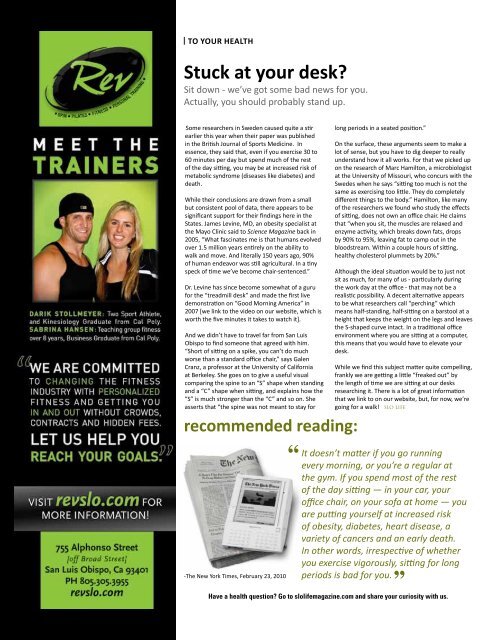SLO LIFE Winter 2010
You also want an ePaper? Increase the reach of your titles
YUMPU automatically turns print PDFs into web optimized ePapers that Google loves.
To Your HealTH<br />
Stuck at your desk?<br />
Sit down - we’ve got some bad news for you.<br />
Actually, you should probably stand up.<br />
Some researchers in Sweden caused quite a stir<br />
earlier this year when their paper was published<br />
in the British Journal of Sports Medicine. In<br />
essence, they said that, even if you exercise 30 to<br />
60 minutes per day but spend much of the rest<br />
of the day sitting, you may be at increased risk of<br />
metabolic syndrome (diseases like diabetes) and<br />
death.<br />
While their conclusions are drawn from a small<br />
but consistent pool of data, there appears to be<br />
significant support for their findings here in the<br />
States. James Levine, MD, an obesity specialist at<br />
the Mayo Clinic said to Science Magazine back in<br />
2005, “What fascinates me is that humans evolved<br />
over 1.5 million years entirely on the ability to<br />
walk and move. And literally 150 years ago, 90%<br />
of human endeavor was still agricultural. In a tiny<br />
speck of time we’ve become chair-sentenced.”<br />
Dr. Levine has since become somewhat of a guru<br />
for the “treadmill desk” and made the first live<br />
demonstration on “Good Morning America” in<br />
2007 [we link to the video on our website, which is<br />
worth the five minutes it takes to watch it].<br />
And we didn’t have to travel far from San Luis<br />
Obispo to find someone that agreed with him.<br />
“Short of sitting on a spike, you can’t do much<br />
worse than a standard office chair,” says Galen<br />
Cranz, a professor at the University of California<br />
at Berkeley. She goes on to give a useful visual<br />
comparing the spine to an “S” shape when standing<br />
and a “C” shape when sitting, and explains how the<br />
“S” is much stronger than the “C” and so on. She<br />
asserts that “the spine was not meant to stay for<br />
recommended reading:<br />
-The New York Times, February 23, <strong>2010</strong><br />
long periods in a seated position.”<br />
On the surface, these arguments seem to make a<br />
lot of sense, but you have to dig deeper to really<br />
understand how it all works. For that we picked up<br />
on the research of Marc Hamilton, a microbiologist<br />
at the University of Missouri, who concurs with the<br />
Swedes when he says “sitting too much is not the<br />
same as exercising too little. They do completely<br />
different things to the body.” Hamilton, like many<br />
of the researchers we found who study the effects<br />
of sitting, does not own an office chair. He claims<br />
that “when you sit, the muscles are relaxed and<br />
enzyme activity, which breaks down fats, drops<br />
by 90% to 95%, leaving fat to camp out in the<br />
bloodstream. Within a couple hours of sitting,<br />
healthy cholesterol plummets by 20%.”<br />
Although the ideal situation would be to just not<br />
sit as much, for many of us - particularly during<br />
the work day at the office - that may not be a<br />
realistic possibility. A decent alternative appears<br />
to be what researchers call “perching” which<br />
means half-standing, half-sitting on a barstool at a<br />
height that keeps the weight on the legs and leaves<br />
the S-shaped curve intact. In a traditional office<br />
environment where you are sitting at a computer,<br />
this means that you would have to elevate your<br />
desk.<br />
While we find this subject matter quite compelling,<br />
frankly we are getting a little “freaked out” by<br />
the length of time we are sitting at our desks<br />
researching it. There is a lot of great information<br />
that we link to on our website, but, for now, we’re<br />
going for a walk! <strong>SLO</strong> <strong>LIFE</strong><br />
“<br />
It doesn’t matter if you go running<br />
every morning, or you’re a regular at<br />
the gym. If you spend most of the rest<br />
of the day sitting — in your car, your<br />
office chair, on your sofa at home — you<br />
are putting yourself at increased risk<br />
of obesity, diabetes, heart disease, a<br />
variety of cancers and an early death.<br />
In other words, irrespective of whether<br />
you exercise vigorously, sitting for long<br />
periods is bad for you.<br />
”<br />
Have a health question? Go to slolifemagazine.com and share your curiosity with us.<br />
24 | slo life magazine


















